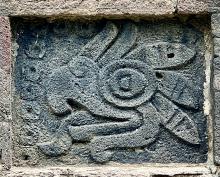Cuauhtlan (Mdz24v)
This simplex glyph for the place name Cuauhtlan shows simple an eagle's head in profile, looking to the viewer's right. The word for eagle is cuauhtli, and the stem is -cuauh. The locative suffix (-tlan) is not shown here visually. The eagle's head has brown feathers in two tones of brown, dark and lighter, and some grayish feathers right near its face. Its eye is yellow, as is its beak, with the exception of the tips, which are black. Its beak is open, showing a red tongue.
Stephanie Wood
There is another Cuauhtlan glyph, a compound glyph, in the Codex Mendoza on folio 13 verso. That one has an eagle's head and the two front teeth to stand for the phonetic -tlan suffix. There is also another Cuauhtlan glypn that is simply a standing eagle.
The differences of scholarly interpretation for this glyph are not great. Unlike Berdan and Anawalt, Karttunen does not see the locative suffix -tlan (which is supported by the teeth) as meaning a place of abundance of a certain thing. Karttunen preserves that reading for the locative suffix -tla. The gloss definitely supports the paleography of the -tlan suffix. That said, there are intrusive n's, and there is a noun "cuauhtla" (also spelled "cuauhtlah") which means woods, forest, wilderness, and could serve as a place name.
It is worth noting that this place name uses the -tlan postposition on the stem that once had the -tli absolutive (cuauhtli, eagle). Whereas, the place name Cuauhtitlan uses the -titlan postposition on the stem that once had the -tl absolutive (cuahuitl, tree). Whereas, the place name Cuauhtitlan uses the -titlan postposition on the stem that once had the -tl absolutive (cuahuitl, tree). But in the case of Mictlan Cuauhtlan (Mdz49r), the ligature is not used, so it must not be a requirement.
Stephanie Wood
quauhtlan.puo
Cuauhtlan, pueblo
Stephanie Wood
c. 1541, but by 1553 at the latest
Quauhtlan, Quauhtla, Cuauhtla, feathers, plumas
This is an example of a carved stone hieroglyph representing the date Chiucnahui Cuauhtli (Nine Eagle, or 9-Eagle). Diagnostic features are the hooked beak and the feathery tufts from the top to the back of the head. This eagle also has a protruding tongue, so, it shares some features of the eagle in the Cuauhtlan glyph above. The stone carving is located on the Templo Calendárico at the Tlatelolco archaeological site. Photo by R. Haskett, 2 May 2025.

cuauh(tli), eagle, https://nahuatl.wired-humanities.org/content/cuauhtli
-tlan (locative suffix), by, near, among, https://nahuatl.wired-humanities.org/content/tlan
cuauhtla, woods wilderness, forest, mountain, https://nahuatl.wired-humanities.org/content/cuauhtla
"Eagle Place" [Frances Karttunen, unpublished manuscript, used here with her permission.]
"Where There Are Many Eagles" (Berdan and Anawalt, 1992, vol. 1, 202)
"Lugar del Águila" o "Lugar de Águilas"
Stephanie Wood
Codex Mendoza, folio 24 verso, https://digital.bodleian.ox.ac.uk/objects/2fea788e-2aa2-4f08-b6d9-648c00..., image 59 of 188.
The Bodleian Libraries, University of Oxford, hold the original manuscript, the MS. Arch. Selden. A. 1. This image is published here under the UK Creative Commons, “Attribution-NonCommercial-ShareAlike 3.0 License” (CC-BY-NC-SA 3.0).






